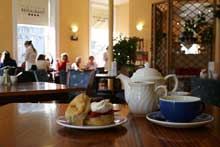|
“立頓”是怎樣成長的
[ 2007-02-12 14:41 ]
 Tea has been finding its way to Britain since the 17th century when it was introduced, originally by Dutch merchants, as an exotic luxury item and a health tonic. Its sales rapidly overtook coffee, in spite of a punitive tax imposed on tea imports specifically intended to protect the coffee trade. Tea went on to become the quintessential symbol of the British way of life. Mary of Modena, then Duchess of York, is credited with introducing tea drinking to Scotland in 1680 when visiting with her husband, later King James VII of Scotland (the king after whom New York is named). Those same British took their tea habit to their North American colonies, resulting, eventually, in the Boston Tea Party and the birth of the United States. And all from a health tonic! Tea has been finding its way to Britain since the 17th century when it was introduced, originally by Dutch merchants, as an exotic luxury item and a health tonic. Its sales rapidly overtook coffee, in spite of a punitive tax imposed on tea imports specifically intended to protect the coffee trade. Tea went on to become the quintessential symbol of the British way of life. Mary of Modena, then Duchess of York, is credited with introducing tea drinking to Scotland in 1680 when visiting with her husband, later King James VII of Scotland (the king after whom New York is named). Those same British took their tea habit to their North American colonies, resulting, eventually, in the Boston Tea Party and the birth of the United States. And all from a health tonic!
In the early years of British tea consumption, the product was an expensive indulgence. Its only source was China and at that time the British authorities placed heavy restrictions on foreign trade. Supplies were increased and prices cut dramatically, however, when Scottish merchant Charles Bruce opened the first commercial tea plantations in India, after his brother Robert discovered tea being grown in Assam, India went on to become and still remains, the world’s largest producer of tea. The tea flowing from India symbolised the acuity of Scots trading instincts.
Scots continued to play a crucial role in the development of the tea trade around the world. In 1876, Thomas J. Lipton opened his first grocer’s shop in his native Glasgow. This was the beginning of what would become one of the largest private fortunes ever built on tea. Buying directly from producers and eventually buying tea plantations himself, Lipton was able to sell tea to the public at reduced prices. He was one of the first merchants to blend tea with the goal of producing a recognisable and consistent “brand” that would be the same in every one of his shops. In 1890, Lipton expanded his tea empire across the Atlantic to New York, where he had spent much of his teens. Eventually, the Scot would go on to control a tenth of the world’s traffic in tea and Liptons remains a name recognised across the States and much of the rest of the world. At the time that tea blending was increasing its popularity, whisky blending was also producing the same increase in sales for the same reasons – a brand that was consistent and recognisable. This was the period when “Scotch” became the world’s preferred spirit. These earlier Scottish merchants were quick to recognise the universal market value of a good brand.
點擊查看本頻道更多精彩內容
|